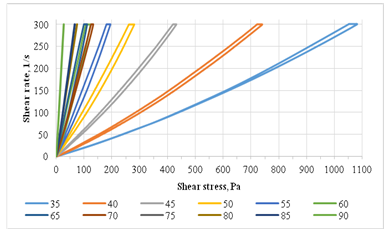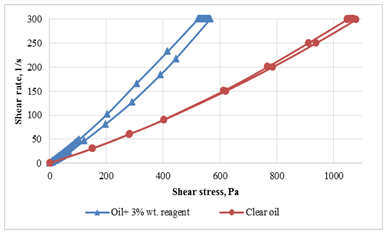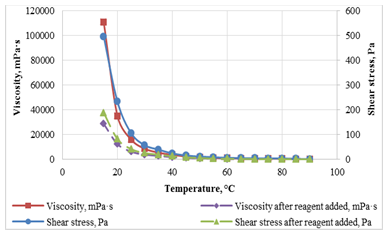ПОДБОР РАСТВОРИТЕЛЯ НА ОСНОВЕ ИЗУЧЕНИЯ РЕОЛОГИЧЕСКИХ СВОЙСТВ НЕФТИ
Рощин П.В.1, Зиновьев А.М.2, Стручков И.А.3, Калинин Е.С.4, Дживорну К.K.5
1 Кандидат технических наук, Национальный минерально-сырьевой университет «Горный»; 2 Кандидат технических наук, Самарский государственный технический университет; 3аспирант, Национальный минерально-сырьевой университет «Горный»; 4 Заведующий лабораторией фильтрационных исследований/кандидат технических наук, ООО «СамараНИПИнефть»; 5студент, Национальный минерально-сырьевой университет «Горный»
ПОДБОР РАСТВОРИТЕЛЯ НА ОСНОВЕ ИЗУЧЕНИЯ РЕОЛОГИЧЕСКИХ СВОЙСТВ НЕФТИ
Аннотация
Целью данной работы является определение влияния различных реагентов на реологические свойства тяжелой нефти, а также разработка эффективного реагента-растворителя на основе проведенных исследований. В последние годы прослеживается тенденция активного ввода в разработку месторождений высоковязкой нефти. По различным данным на территории РФ запасы углеводородов с вязкостью более 30 мПа∙с составляют порядка 8 млрд. т. Большая часть, порядка 95 %, остаточных запасов сосредоточена в Архангельской, Самарской, Тюменской и Пермской областях, а также на территории республик Башкортостан, Коми, Татарстан и Удмуртия. В общей структуре запасов РФ на долю Самарской области приходится порядка 350 млн. т извлекаемых запасов, из которых около четверти (примерно 85 млн. т) приходится на залежи нефти с вязкостью более 30 мПа∙с. В создавшихся условиях представляет особый интерес изучение способов интенсификации добычи подобных нефтей.
Исследования были проведены на ротационном вискозиметре Rheotest RN 4.1 для диапазона температур 90-15 °C. Были замерены вязкость нефти, напряжение сдвига и скорость сдвига до и после добавления к нефти разработанного авторами реагента. Результаты экспериментов показали, что рассмотренная тяжелая нефть Самарской области проявляет тиксотропные свойства даже при высоких температурах (70 °C). Разработанный реагент-растворитель, представляющий собой диспергатор асфальтеновых частиц в нефти, может быть использован для повышения эффективности эксплуатации скважин, основанного на снижении вязкости нефти как в скважине, так и в системе сбора нефти.
Ключевые слова: тяжелая нефть, реагент-растворитель, асфальтосмолопарафиновые вещества.
Roschin P.V.1, Zinoviev А.М.2, Struchkov I.А.3, Kalinin E.S.4, Dziwornu C.K.5
1Candidate of Engineering Science, National Mineral Resources University; 2Candidate of Engineering Science, Samara State Technical University
3 postgraduate student, National Mineral Resources University; 4Candidate of Engineering Science/Laboratory chief of penetration test, LLC; 5student, National Mineral Resources University SamaraNIPIneft
SOLVENT SELECTION BASED ON THE STUDY OF THE RHEOLOGICAL PROPERTIES OF OIL
Abstract
The purpose of this paper is definition of influence of various reagents on rheological properties of heavy oil, and also development of effective reagent-solvent on the basis of the conducted experimental studies. In recent years, there is a tendency of the active bringing into production of heavy oil fields. According to various sources, there are 8 billion tons of hydrocarbon reserves with a viscosity of more than 30 mPa·s in the Russian Federation. More than 95% of the remaining reserves are concentrated in Arkhangelsk, Samara, Tyumen and Perm regions, and in the Republic of Bashkortostan, Komi, Republic of Tatarstan and Udmurtia. In all, about 350 million tons of the total recoverable oil in the Russian Federation is found in the Samara Region, of which about a quarter (approximately 85 million. tons) accounts for deposits of oil with a viscosity of more than 30 mPa·s. As a result, there is a particular interest in the study of intensification methods for the production of these oils.
Investigations were conducted on the rotational viscometer the Rheotest RN 4.1 for the range of temperatures of 90-15 °C, thus oil viscosity, shear stress and shear rate pre- and post- adding of the produced reagent to oil were measured. Results of this research showed that considered heavy oil of the Samara region show thixotropic properties even at high temperatures (70 °C). The produced reagent-solvent, acting as a dispersion agent of asphaltene particles, can be used for increase of oil well operational efficiency, based on reduction of oil viscosity both in tubing and gathering system.
Keywords: heavy oil, the reagent-solvent, asphaltene-resin-paraffin substances.
Introduction
Today in the world there are many production reagents, solvents, for example, various petroleum solvents, xylenes, gas condensate, etc. used in the process of oil recovery. They are applied widely in such methods of production as cyclic pumping of solvent in a production well with the subsequent selection of liquid, VAPEX and its variation [Nikolin, 2007; Batler, 2010; Roschin et al, 2013]. In addition, solvents like surfactants are often added to the suction of well pumps, making it easier to lift the liquid and helping prevent loss of asphaltene-resin-paraffin substances in the tubing and surface equipment, reducing the viscosity of crude oil and weakening its thixotropic properties [2-12]. In the Mining University a reagent-solvent with higher viscosity has been developed, having good dissolving and dispersing properties in relation to the resin and asphaltene, forming three-dimensional structures in the heavy oil [Roschin et al, 2013]. The presence of asphaltenes, resins and waxes leads to anomalies in the flow of highly viscous oil in porous medium, and the thixotropic structure of coagulation and coagulation-crystallization types are characterized by shear stress destruction, which complicates the fluid influx into the production well [Gafarov, Shamaev, 2005; Zinoviev et al, 2014]. The use of reagent-solvent allows for the reduction of the viscosity of crude oil, facilitating its production and transportation.
In the Russian oil industry, a wide range of solvent-reactants are used. Petroleum ether is a light benzine which is obtained by distilling a light fraction of distilled oil. It is used as a solvent for flushing out of wells and treating of hole-bottom region. Depending on the temperature of distillation, light and heavy ethers can be distinguished. An ether is considered light if it is obtained at temperatures below 70ºC and heavy if obtained between 70-100ºC. Petroleum ether Nefras S2-80/120 showed high efficiency when added to waxy oil from the Petrukhnovskoe field [Roschin et al, 2013]. Also it should be emphasized that white spirit (Nefras-S4-155/200) is the product of the straight distillation of crude oil (light fraction benzine) with a high content of aromatic hydrocarbons (up to 16%). It is used as a component of solvent mixtures in the treatment of bottomhole formation zones of reservoirs and the borehole.
Xylene is a mixture of ethylbenzene and three xylene isomers. Xylene is obtained during the aromatization of petroleum fractions. Ortho-xylene is obtained from the rectification of xylene. Xylene is actively used as a solvent in the treatment of hole-bottom region of pay zones with high viscosity oil. It is also used to dissolve resin and asphaltene deposits in producing wells and oil pipelines. According to the results of several laboratory experiments, xylene has proven to be an effective solvent when added to samples of high viscosity oil.
Also, there are a number of alcohols used as components of various mixtures during the treatment of bottomhole formation zones of reservoirs. Isopropyl alcohol is a product of the hydrogenation of acetone or propylene hydration. This alcohol reduces the interfacial tension at the "reagent - oil" frontier in the compositions used in the treatment of hole-bottom region. It is also used as a component of solvent-reactants. Nefras-A-130/150, is widely known as a petroleum solvent with the highest weight content of aromatic components of the benzene series. It is most often used in the treatment of bottomhole formation zones and removing asphaltene and wax deposits.
TEMPERATURE AND REAGENT EFFECT ON THE RHEOLOGICAL PROPERTIES OF OIL
For the experiment heavy oil was selected from a formation in the Samara region (viscosity at 20 °C is 35200 mPa∙s), with the mass content of asphaltenes and resins up to 75%. The hydrocarbon-bearing formation is characterised by fracture-porous carbonate rock. For research of the rheological properties of a sample of high-viscosity oil dynamic tests were carried out at various temperatures on the Rheotest RN 4.1 device in the Mining University (St. Petersburg). The study of the thixotropic properties was carried out using specific procedures described in papers [Devlikamov et al, 1975; Rogachev, Kolonskih, 2006; Roschin et al, 2013; Zinoviev et al, 2014].
Figure 1 displays the plots of the shear stress versus shear rate at different temperatures, forming the typical hysteresis loop area which indicates the presence of oil thixotropic properties at a given temperature.
Figure 1 - The dependence of shear stress versus shear rate for the sample of heavy oil at different temperatures
The diagram shows that even at 70 °C oil has thixotropic properties. The experiment at temperatures below 35 °C is not possible due to limitations of the range of operation of the Rheotest device.
To investigate the influence of produced reagent-solvent that is a mixture of unsaturated fatty acids and aromatic hydrocarbons on the thixotropic properties of heavy oil, an experiment was carried out with the oil with the addition of a solvent at a concentration of 3% by weight. Figure 2 shows the experimental results obtained at 35 °C.
Figure 2 - The dependence of shear stress versus shear rate for clean oil and the oil with the addition of the reagent-solvent in a concentration of 3% wt at 35 °C
While conducting experiments the shear stress of thixotropic structure destruction in highly viscous oil was determined. Methodology for conducting the experiments described in the papers [Roschin et al, 2013; Zinoviev et al, 2014]. Figure 3 presents the results of adding the solvent in the investigated high-viscosity oil.
Figure 3 - The dependence of the effective viscosity and shear stress versus temperature for clean oil and the oil with the addition of the reagent-solvent in a concentration of 3% wt
Figure 3 clearly shows that the produced solvent reduces viscosity of heavy oil (almost 4 times at 15 °C and 2 times - at 90 °C) and shear stress of thixotropic structure destruction at various temperatures. The designed solvent has dissolving and dispersing actions in relation to the coagulation structure formed by the asphaltenes and resins due to the content of xylene and fatty acids.
Conclusions
The combination of thermal exposure (steam flooding) and the addition of the reagent-solvent can significantly reduce viscosity and shear stress in flow of oil in the reservoir, and as it moves along tubing and flowlines.
Acknowledgments
We would like to acknowledge the contribution of Dr. A.V. Petukhov and Dr. M.K. Rogatchev for their assistance during the conduction of the experiments. Finally, we would like to thank University of Mines (Saint Petersburg, the Russian Federation) which provided laboratory equipment support and samples for this research.
References
[1] Nikolin I.V. Methods of development of heavy oil and natural bitumen // Science - foundation for solutions to the technological problems of Russia's development. - 2007. - №2. p. 54-68.
[2] Roschin P.V., Petukhov A.V., Vasquez Cardenas L.C., Nazarov A.D., Khromykh L.N Issledovanie reologicheskikh svoystv vysokovyazkikh i vysokoparafinistykh neftey mestorozhdeniy Samarskoy oblasti. Neftegazovaya Geologiya. Teoriya I Praktika, 2013, vol. 8, no. 1, http://www.ngtp.ru/rub/9/12_2013.pdf [Research of the rheological properties of high-viscosity and high-paraffinic oilfields of the Samara region. "Oil and gas geology. Theory and practice", 2013, vol. 8, No. 1.].
[3] Zinoviev A.M., Kovalev A.A., Maksimkina N.M., Olhovskaya V.A., Roschin P.V., Mardashov D.V. The basing of recovery mechanism of non-Newtonian viscous oil based on field-geological data fusion. «Vestnick CKR Rosnedra», 3/2014, p. 15 – 23.
[4] Zinoviev A.M., Olkhovskaya V.A., Konovalov V.V., Mardashov D.V., Tananykhin D. S., Roschin P.V. Research of rheological properties and features filtering of high-viscous oil at fields of the Samara region. Vestnick SamGTU. 2 (38). p. 197-205.
[5] Orlov M.S., Kishchenko M.A., Konovalov K.I., Penkov G.M., Bakiev M.D. The investigation of solvents properties which are used in oil and gas industry. In-ternational Research Journal. 2-4 (33). p. 80-83.
[6] Ametov I.M., Bajdikov Ju.N., Ruzin L.M., Spiridonov Ju.A. Dobycha tjazhelyh i vysokovjazkih neftej. – M.: Nedra, 1985. – 205 s.
[7] Batler R.M. Gorizontal'nye skvazhiny dlja dobychi nefti, gaza i bitumov. – M. – Izhevsk: Institut komp'juternyh issledovanij, NIC «Reguljarnaja i haoticheskaja dinamika», 2010. – 536 s.
[8] Gafarov Sh.A., Shamaev G.A. Issledovanie fil'tracionnyh parametrov nen'jutonovskoj nefti pri techenii v karbonatnyh poristyh sredah // Jelektronnyj nauchnyj zhurnal «Neftegazovoe delo» http://www.ogbus.ru/authors/Gafarov/Gafarov_3.pdf. – 2005. - № 1.
[9] Devlikamov V.V., Habibullin Z.A., Kabirov M.M. Anomal'nye nefti. - M.: Nedra, 1975. – 168 s.
[10] Mirzadzhanzade A.H., Kovalev A.G., Zajcev Ju.V. Osobennosti jekspluatacii mestorozhdenij anomal'nyh neftej. M.: Nedra, 1972. – 200 s.
[11] Rogachev M.K., Strizhnev K.V. Bor'ba s oslozhnenijami pri dobyche nefti. M.: Nedra, 2006. – 295 s.
[12] Rogachev M.K., Kolonskih A.V. ISSLEDOVANIE VJaZKOUPRUGIH I TIKSOTROPNYH SVOJSTV NEFTI USINSKOGO MESTOROZhDENIJa Neftegazovoe delo. 2009. T. 7. № 1. S. 37-42.



